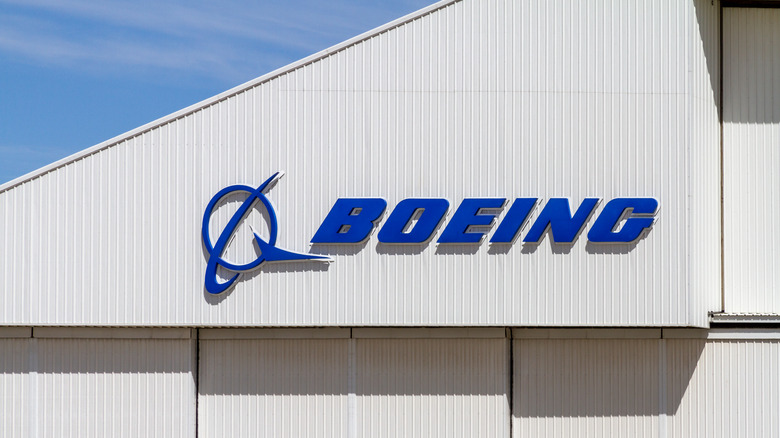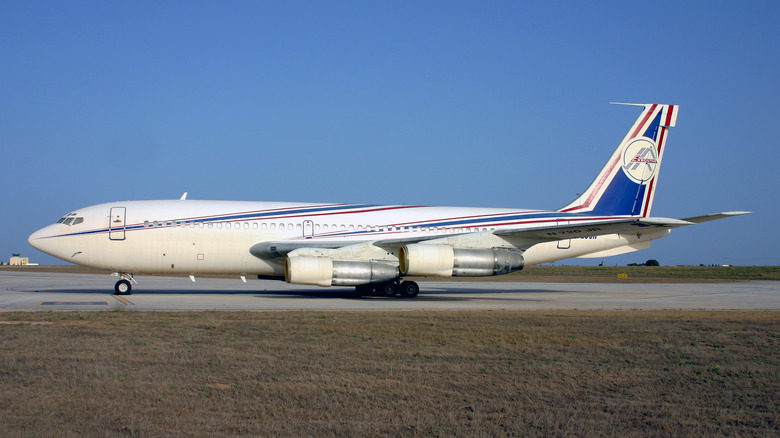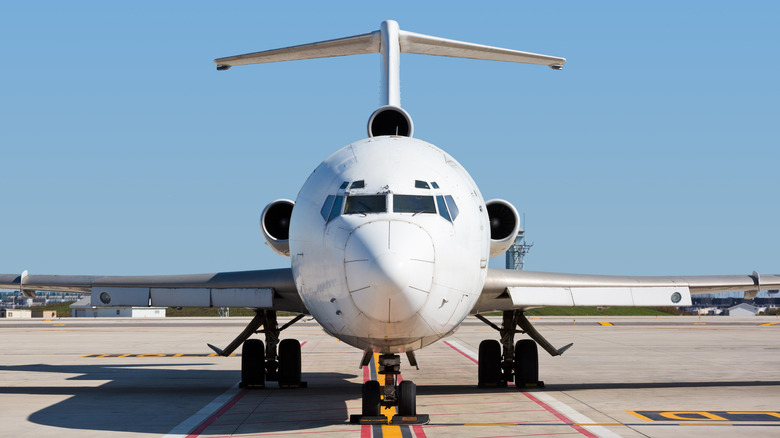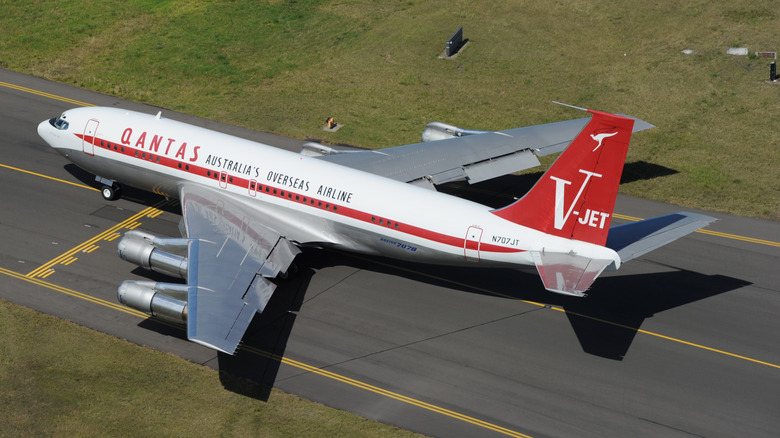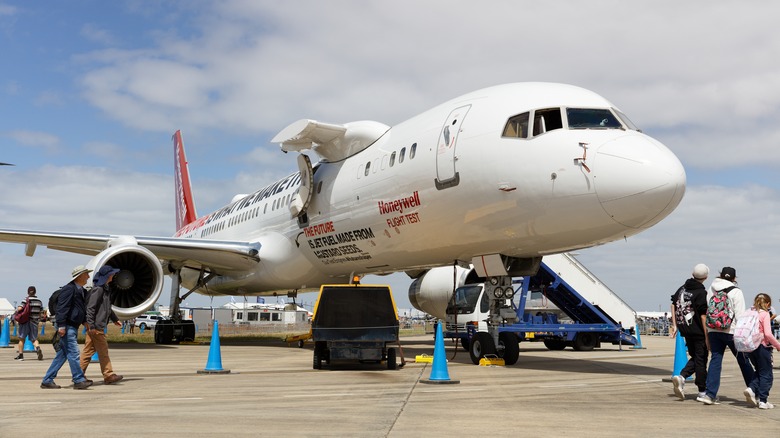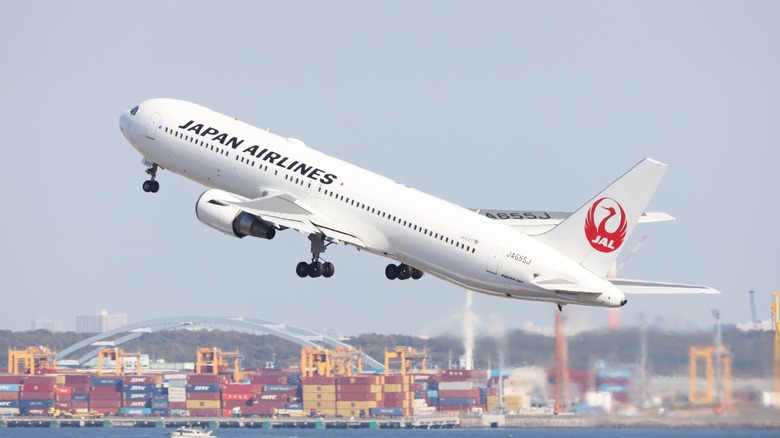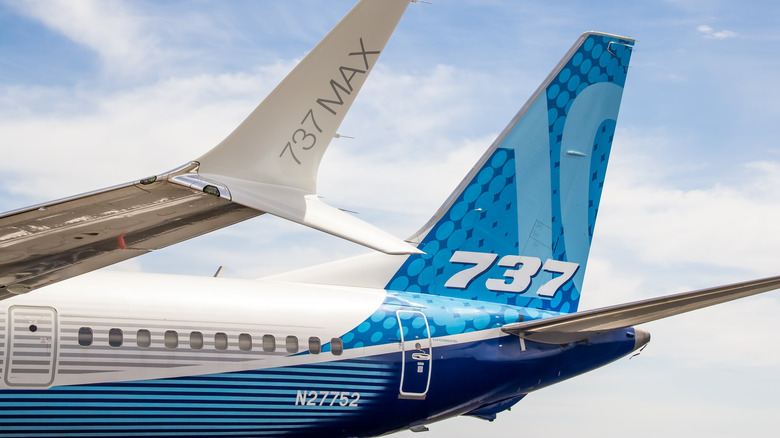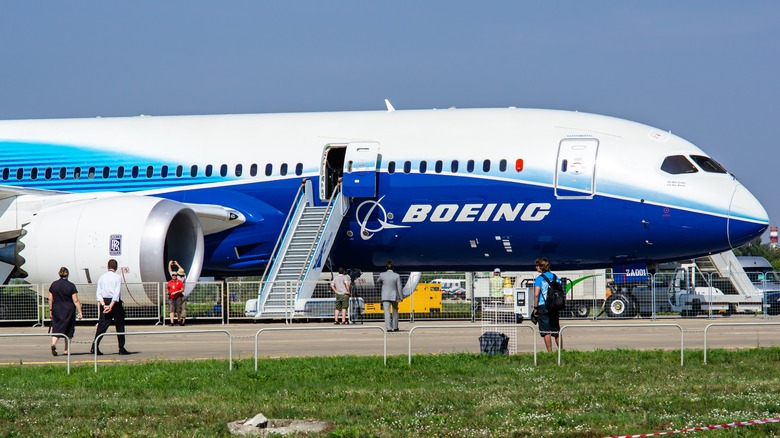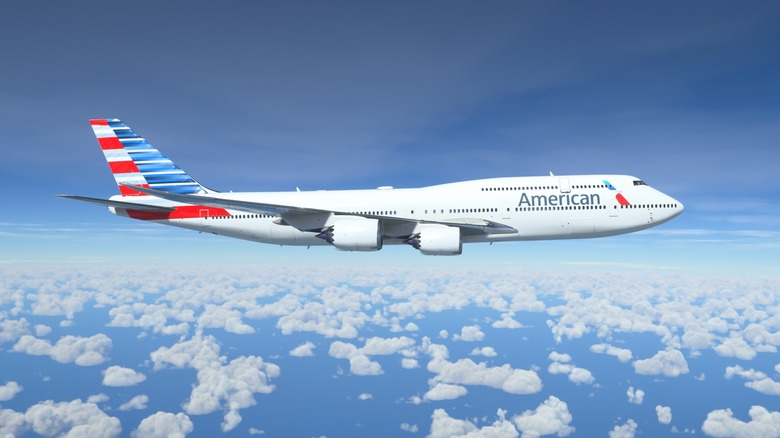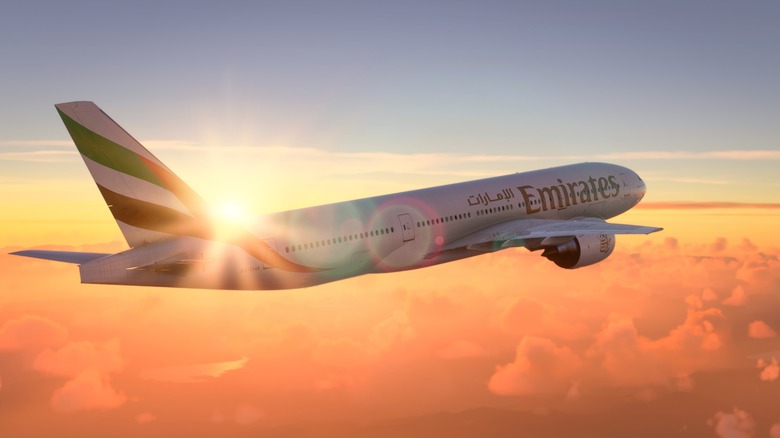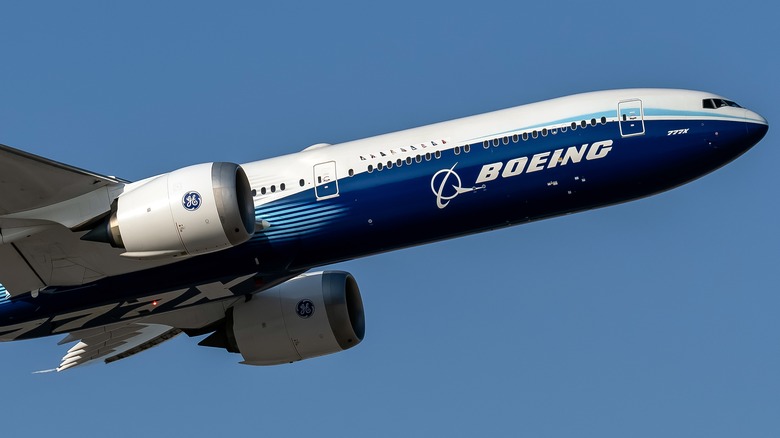Every Boeing Passenger Jet Ranked From Worst To Best
The name Boeing immediately conjures thoughts of aircraft like the jumbo jet, or the infamous 737 MAX. The company embodies the history of the passenger jet. But it wasn't always this way. Beginning as a manufacturer of military planes, it wasn't until the 1950s that Boeing made its first foray into the passenger jet market. The de Havilland Comet had paved the way, but several high-profile crashes meant that further development was mired in arguments about cost and safety.
It took a level of audacious risk-taking and spectacular engineering for Boeing to convince the world that jet airliners were the future. Success followed, and Boeing has been at the forefront of commercial aviation technology ever since, producing some of the most iconic planes to take to the skies. Technology has advanced, markets have developed and regulations have changed of the years. Each jet is a product of its era, and each has made a contribution to Boeing's enduring legacy as a pioneer of passenger jet travel. But some have been more influential and enduring than others.
As such, we explored every Boeing passenger jet ranked from worst to best, delving into aviation history, from the 1950s to the modern era and examining how technology, regulations, and market demands have shaped Boeing's aircraft. Our rankings consider the aircraft's technological advancements, operational performance, safety record, production numbers, service longevity, and cultural legacy. Let's see which jets fare poorly and which ones have stood the test of time.
9. Boeing 720
The Boeing 720 is the only Boeing passenger jet that doesn't follow the 7x7 naming convention we are all familiar with today. Overshadowed by its more iconic siblings, the 720 was launched in 1959 as a derivative of the 707 and was designed as a stopgap before the 727 was released. The 720 was doomed from the start. Boeing never planned for it to be a cornerstone of their fleet. It was designed for medium-range routes and short runways. Its reduced weight and shortened fuselage offered some fuel efficiency benefits over the 707, but its technological impact on aviation and its operational record is unremarkable, albeit respectable.
The aircraft saw a limited production run. Between 1959 and 1967, Boeing bult just 154 of the 720s before production ceased for good. It entered service with United Airlines in July 1960, and other operators quickly followed suit. The aircraft was technically a business success for Boeing, as development costs were low and they made money off it. Its safety record, while not perfect, was generally acceptable and comparable to other aircraft of its time.
The historical impact of the Boeing 720 is perhaps the most important factor in its ranking. Unlike the 707, which revolutionized air travel, or the 747, which redefined long-haul flying, the 720 left a relatively minor footprint. Its limited production and short service life meant it never achieved the iconic status of other Boeing aircraft.
8. Boeing 727
With the success of the 707, Boeing recognized the need for a new aircraft that could address emerging market demands and regulatory requirements. The new plane needed three engines to meet safety regulations and perform well on short to medium-haul flights from shorter runways. The burgeoning demand for air travel meant capturing this market segment was highly profitable. Enter the Boeing 727. Introduced in 1963, its innovative trijet design enabled it to operate from shorter runways, granting access to airports that were previously off-limits to larger jets. This operational advantage made the 727 ideally suited to the expanding aviation market.
Initially considered a risky development, the 727 proved to be a wild success. Over its production run, which lasted until 1984, Boeing manufactured more than 1,800 units. It was Boeing's best-selling aircraft until the 737 knocked it off its perch. This widespread adoption reflected its popularity among airlines and customers alike.
So why do we rank the 727 so low? First, it had several serious issues from the outset. Fuel efficiency was poor, and it was very noisy. More notably, it suffered several high-profile accidents. Of the 1,800 jets produced, 120 were lost in accidents, resulting in nearly 4,000 fatalities. Eventually, it proved obsolete as better aircraft were developed. Still, the Boeing 727 was a revolutionary machine, bridging the gap between smaller regional aircraft and larger long-haul jets. It democratized air travel by making it more accessible to the masses.
7. Boeing 707
In 1958, the Jet Age truly began when Pan American flew the 707 for the first time. It was Boeing's first jetliner, and they bet everything on its success. Up to this point, Boeing was not a major player at all in commercial airliners, but the 707 changed everything. People already knew its capabilities. Development had begun in 1952 and, in a test flight in 1955, Tex Johnson wowed the crowd by completing two barrel rolls in the aircraft. This was a special plane.
It revolutionized air travel. Departing from the piston-engine planes popular in this era, it significantly reduced flight times and increased passenger capacity. The aircraft's design, featuring four engines mounted under swept-back wings, set the standard for future airliners. It offered a far more comfortable flying experience and was capable of crossing the Atlantic non-stop. This all opened up countless new possibilities for airlines and passengers alike, and it helped establish Boeing as a leader in commercial aviation, a position it has held ever since.
Its operational performance was a key strength, as it was praised for its speed, range, and reliability. Though not necessarily safe by today's standards, it was a marked improvement on the Comet, the first passenger jetliner. It was an unequivocal success, selling over 800 units globally. Despite its groundbreaking nature, the 707's technology has become outdated compared to modern jets. But it was a pioneer. The Boeing 707 not only changed how airlines operated, but it also had a lasting effect on global travel and commerce, making it one of the most important aircraft in aviation history.
6. Boeing 757
By the 80s, Boeing was ready to modernize and introduce a direct replacement for the 727. The Boeing 757 jet entered service for Eastern Airlines in 1983, and it was capable of serving short and long-haul routes. Designed as a narrow-body, twin-engine jet, it could accommodate about 200 passengers. It was 80% more fuel efficient than the 727, and it struck a perfect balance between efficiency and capacity. It was also a much quieter plane than the 727, making it a superior plane by nearly every measure.
One of its key strengths was its ability to serve both domestic and transatlantic routes, meaning that airlines could diversify their service ranges without having to invest in multiple aircraft types. It also had a high thrust-to-weight ratio which meant it could easily take off from short runways and at high altitudes. This made it particularly useful for carrying out operations at notoriously challenging airports.
There are many areas where the 757 excels that it still hasn't been replaced yet. Its advanced avionics and flight systems still work well today. Its safety record is excellent, with only a few accidents to speak of. It has sold over 1,000 units globally, and its robust design and reliable performance mean that many of those planes are still flying today. Production ceased in 2004, but the legacy of the 757 is one that Boeing will certainly be proud of.
5. Boeing 767
Developed in tandem with the 757, the Boeing 767 was the company's first wide-body twinjet and was introduced in 1982. It pioneered a new generation of aircraft with its advanced avionics. It was the first Boeing aircraft to feature a glass cockpit and helped bring aviation into the digital age.
The 767 shares many features with its 757 sibling, resulting in significant cost savings in development and production. Its advanced avionics, aerodynamics, and lighter materials contributed to improved fuel efficiency and extended range, allowing it to serve routes previously operated by larger, less efficient aircraft like the 747. With a strong safety record and reliable performance, the 767 has sold nearly 1,500 units across its various models.
Throughout its lifespan, the 767 has adapted to market demands. Initially serving as a passenger jet, it now excels as a workhorse in cargo and military roles. The pandemic led to a significant drop in passenger flights operating the 767. This has shifted its primary role to cargo operations, with FedEx as its largest operator. Although the 767 is now in its twilight years as airlines opt for more fuel-efficient next-generation aircraft, its legacy is firmly cemented in aviation history. It helped bridge the gap between narrow and wide-body aircraft, and its ability to serve a wide range of routes and industries has contributed to its popularity and longevity.
4. Boeing 737
The Boeing 737 is a poisoned chalice for Boeing. It is the best-selling commercial jetliner in aviation history, with over 10,000 units delivered since its introduction in 1968. Ryanair exclusively operates a fleet of 737s. However, the infamous events involving the MAX plunged the company into controversy and severely damaged its reputation.
The 737 has become a mainstay for airlines worldwide. It is renowned for its reliability, versatility, and efficiency. The original 737 offered short to medium-haul capabilities for around 100 passengers and set the scene for its more advanced variants. Subsequent iterations, including the Classic series of the 1980s and the Next Generation series of the late 1990s, saw improvements in capacity, range, fuel efficiency, and avionics, cementing the 737's dominance in the short to medium-haul market.
The 737 MAX, introduced in the 2010s, became the fastest-selling aircraft of all time. It aimed to improve fuel efficiency and reduce operational costs. However, two fatal crashes led to Boeing grounding models 8 and 9. Critical flaws in the aircraft's design and software systems were found, prompting extensive scrutiny and regulatory changes. But despite the MAX disasters, the 737 has a strong safety record and has continuously improved over its five-decade production run. Its ability to adapt to changing market demands and technological advancements has guaranteed its status as an aviation icon. It has been a spectacularly successful aircraft for Boeing. Will it survive the blunders of the MAX series? Time will tell.
3. Boeing 787 Dreamliner
At the turn of the millennium, the airline market changed. Fuel efficiency and environmental standards featured prominently as key requirements in aircraft design. Boeing responded with the 787 Dreamliner, an aircraft that aimed to set new standards for long-haul flights. The new design incorporated advanced composite materials, making up 50% of its structure. This, combined with its cutting-edge aerodynamics and state-of-the-art engines, resulted in an aircraft design that offers incredible range with vastly increased fuel efficiency. Perfect for the new era of air travel.
However, there were teething problems. Boeing had begun outsourcing its manufacturing to other companies to cut costs. While this saved money, it also meant that they lost control of the manufacturing process. This, coupled with the challenging technical side of development, resulted in major delays in delivering the aircraft to customers. This legacy of outsourcing still has major reverberations today.
That said, once the Dreamliner reached the market in 2009, its operational performance and passenger comfort showed that Boeing was still a global leader in aviation technology. Its range and fuel efficiency are unparalleled. The quieter engines, larger windows, and improved aerodynamics result in a smoother flight for passengers. Its advanced avionics and fly-by-wire systems also improve its handling and safety. The Dreamliner has been a major success, with over 1,000 units delivered and more on order. Its impact on the aviation industry is profound, setting new benchmarks for efficiency, sustainability, and passenger comfort.
2. Boeing 747
Perhaps the most famous entry on our list, the 747 is a truly legendary icon of air travel. Known as "The Queen of the Skies," it was introduced into service by Pan Am and has been flying ever since. Characterized by its distinctive humpbacked upper deck, it pushed the boundaries of aviation technology and heralded the beginning of the jumbo jet age.
So what made the 747 so special? Its size. With four engines and a gargantuan fuselage, it was a formidable engineering achievement. Its unprecedented range and capacity allowed airlines to offer cheaper long-haul flights and helped open up global travel and tourism for the masses. There have been many upgrades and improvements through the years, the 747 has been constantly adapting to market demands and incorporating new technologies. This includes advanced avionics, increased fuel efficiency, and extended range. The last model, the Boeing 747-8, is the culmination of 50 years of continuous service, and it offers the most advanced iteration of the jumbo jet.
Through its 50 years of service and 1,500 units sold, its operational performance has been exceptional. Its range, reliability, and capacity have cemented it as a favorite among carriers and passengers alike. Despite a few high-profile accidents, it remains one of the safest aircraft to ever fly. Slowly but surely it is being retired from service as the fleet ages and airlines opt for more modern, fuel-efficient alternatives. But the impact of the 747 is staggering and, for many, it symbolizes the golden age of air travel.
1. Boeing 777
By the late 80's, Boeing offered a great range of aircraft. The 737 dominated the short-haul market, while the 747 was the iconic long-haul aircraft of choice. However, a change in regulations that allowed twin-engine designs to fly transatlantic routes presented an opportunity to develop a new jet. Released in 1995, the 777 was a long-range, wide-body twin-engine jet. It was the first of its kind and embodied what the future of air travel would look like in the 21st century.
Air travel at the turn of the millennium was a challenging landscape that presented plenty of difficulties and opportunities. Ever-evolving regulations coupled with market demands meant that efficiency, reliability, passenger comfort, and range were paramount, while capacity became a somewhat secondary concern. The 777 fits the bill perfectly and has become the best-selling wide-body aircraft of all time. It is now the mainstay of many fleets and the go-to aircraft for long-haul flights. Its operational performance has been exemplary. Its powerful twin-engine design provides excellent fuel efficiency which reduces costs for carriers. Its range is perfect for connecting international hubs. The 777-300 is now a favorite for ultra-long-haul routes.
The aircraft's legacy is already very impressive, and with the highly anticipated release of the 777-X, the story isn't over yet. The Boeing 777 series stands out as the best in Boeing's lineup due to its exceptional balance of performance, efficiency, capacity, and passenger comfort. Its continuous evolution ensures that the 777 remains a leader in the aviation industry.
How did we choose these planes?
When ranking Boeing's passenger jets, we took many different things into consideration. Through a combination of key criteria we arrived at a list that we feel does justice to Boeing's illustrious history as a leading provider of passenger aircraft, without sycophantically presenting a buyer's guide.
First, we chose to focus on aircraft series, rather than individual models. Doing so allowed us to capture the broader evolution of Boeing's engineering and design philosophy. This approach also enabled us to discuss models like the 737 MAX within the context of the entire 737 family, balancing its controversies with its overall achievements. We were very interested in how each jet revolutionized air travel, so we looked at what new developments and features each jet offered, as well as the influence the aircraft had on subsequent designs.
Boeing prides itself on the quality of its engineering, and flying is often touted as the safest form of travel, so we had to consider the operational performance and safety of each jet. This includes their range, efficiency, adaptability, and durability. It also factors in the reliability and safety of each plane over the years. Planes are extremely expensive to develop and purchase. As such production and service life were other key factors. We looked at the number of units built and their longevity in service. And finally, some designs are instantly recognizable to people around the world. So we considered their cultural legacy, which, although clearly subjective, gauges how iconic an aircraft is.
